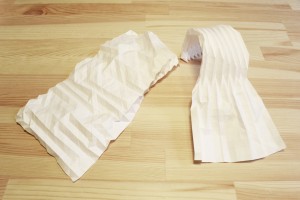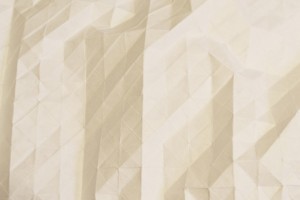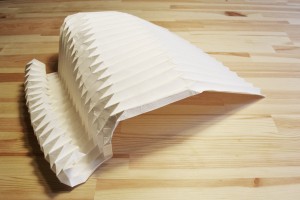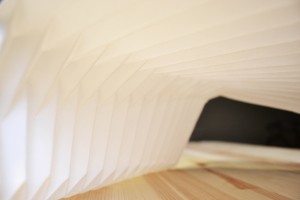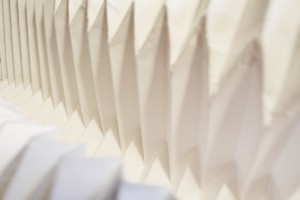Silence, by definition, is complete absence of sound. However, this would be impossible in real life. If there is complete absence of sound around you, you would at last hear your own heart beat. Therefore, silence isn’t complete absence of sound, rather it is an absolute focus on a single sound due to the absence of other sounds.
I read an article about silence in our generation. People say our generation is in complete lack of silence. Meaning, we don’t give enough attention to our silence when it is all around us. I experience silence everyday, and I haven’t given it much attention until I started this project. So I decided to record a portion of my day, when I experience silence the most; at night right before I go to bed.
This instillation forces people to listen to my silence, the silence I experience during my ordinary day. There is a speaker installed at the ver y top of the canopy, and the sound of silence travels through the dark funnel of fabric. As the sound travels through the dark space, people become more and more aware of the silence as the darkness forces them to rely on their hearing. This is a complete appreciation for the sound that is going extinct.


Before anything, I need to settle on the sounds I want the speakers to play. I tried to think of the sensation I wanted people to feel when walking through this tunnel of fabric. I don’t want to recreate an existing atmosphere, I want to let people experience an atmosphere they have never experienced before. While browsing through ambient sounds in youtube, I ran into a video 10 Hours Rainfall. It’s a video playing sounds of rainfall for 10 hours. I thought it would be unusual for people to experience a rainfall in a dry setting. They would be just hearing but not actually feeling the rainfall.
In terms of dyeing the fabric, I think I will use the Shibori dyeing technique. Here are some images done in Shibori teachnique.

Or I might end up doing the simple dyeing technique. Much like the image below.
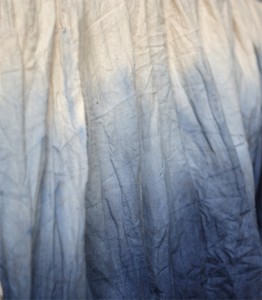
Some of the dyeing techniques used for the textile used for a runway show also seems to create a beautiful atmosphere.

For the final project, I’m planning on continuing my studies on fabric speakers. I looked at several artists for visual and conceptual inspiration. Janet Cardiff recently did a project called Forest where she installed more than 30 speakers in a forest, each speaker emitting “near synchronicity of natural or mediated sounds” (Gregory Volk).

I also looked at David Tudor’s Rainforest collection. This music collection was of “endangered” sounds we would hear in rainforest. It is said that “the result is a timeless sonic environment full of rech textures offering the listener an infinite variety of aural densities and spatial effects. Intensely alive and unlimited” (mode 64).
It seems that to distinguish this fabric speaker as an art piece, having a conceptual idea would be very important. Otherwise, it would just become another form of speaker. I thought about what kind of sound I would want the speakers to make. I think it would be smart to play sounds that would add to the characteristics of the fabric speaker, which is soft and small. Like whispers of sound and music.
Visually, I’ve been inspired by Christo and Jeanne-Claude’s The Gates piece. The color, texture, and the instillation seemed visually so beautiful.
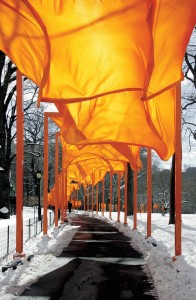
I’ve also looked at Robin Minard‘s works. His work is the most closely related to mine where he installed vines of speakers on the wall. His work somewhat imitates how ivy would grow on the walls. Visually, I thought his work was also simple yet captivating.
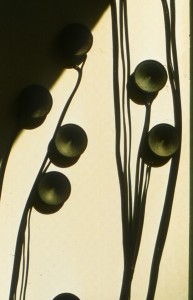
I decided to create a wall of fabric, Initially, I wanted to have two walls of fabric hanging from the ceiling, much like a tunnel of fabrics. To me, big sheets of fabric hanging down from the ceiling recreates the atmosphere of a forest: being overwhelmed by the height and walking aimlessly through the trail. I thought it’ll be interesting to recreate that atmosphere in an urban setting.




Behind the scenes. I wanted to dye the fabric first. I’ve never dyed anything so I thought this assignment will serve as a good opportunity to experiment. I got Royal Blue and Sunshine Orange. I thought these colors would successfully convey the ambient atmosphere I was envisioning for the assignment. I kept listening to Ulrich Schnauss’ Celine while making this piece.

I created a prototype of a thread speaker to see if a conductive thread can act as a speaker. Surprisingly, the thread did play music, but it was very faint.
Also, I needed to see if I have to hand sew the thread speaker onto the fabric, or if I can use the sewing machine. I ended up hand sewing the speaker since I found it difficult to control the sewing machine. Because the speaker was in a spiral, I needed control over the needle.

After sewing the speaker onto the fabric, I connected the two ends of the speaker thread to a circuit to see if it actually worked. Unfortunately, I couldn’t get it to work last night, but I’m hoping it was the problem with how I connected the circuit board, rather than the problem of the actually thread speaker.

This piece is done in the 17th floor lobby of the Hilton Pattaya Hotel.

And this piece was done by Adrianopoulos and Associates.
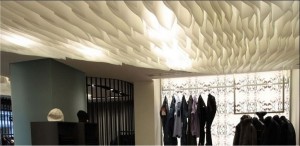
Recalling an artist we looked at earlier, Do Ho Suh, I was drawn to his ability to create such an unusual space using fabrics extending from the ceiling. Studio Lilica is another group of artists who explores ways of creating sculptural pieces or lightings using fabric that extends from the ceiling. 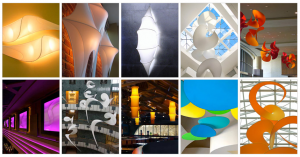
I find both aesthetic and metaphoric beauty in the extension of fabrics at a mass scale. The environment it creates is very mystical, putting you at a setting simliar to a deep forest full of trees overwhelming, with path of shadows on the ground. They are both environments you can only experience in vey specific places.
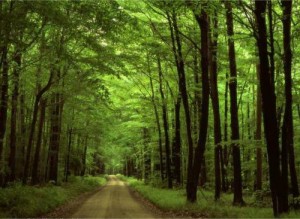
Ronan And Erwan Bouroullec are another architects who create overwhelming space using textiles.
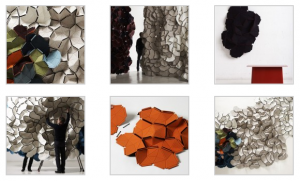
“This is a modular room-dividing system called Clouds consists of textile pieces held together with elastic bands to make free-standing or hanging structures, which can be used to divide space and absorb sound.”
It seems evident that when we use fabrics/textiles sculpturally, we percieve the material in a completely different way from seeing them as a material for clothing.
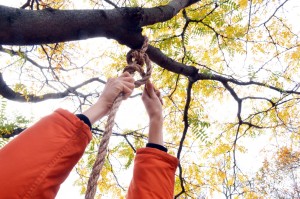

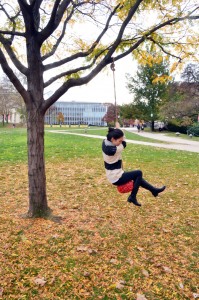
For this piece, I was inspired by Shinkichi Tajiri’s Friendship Knot. To turn something we trivialize into something so grand and big instantly grabbed my attention. We tend to do things, wear things, get things without paying attention to where they came from and why they were created. It makes us sit still and think for awhile of the things we trivialize. That’s what I got from Tajiri’s Friendship Knot. Similar to that piece, I wanted to display something we trivialize in public in its unconventional size to make people perceive something that has very small presence in our lives differently.
This Red Ball of Yarn has a deeper conceptual meaning. There is a single knot made in the center and the threads are just wrapped around that knot. This continuous ravel of the threads represents both connection and complication in relationships. And for people to interact with this piece in public in playful manner lets people forget about all the small complications in life.
Since this week is about knot making, I thought it would be nice to share an artist who works with pins and threads, Debbie Smith. Her work is entirely made up of these two materials, creating a big-scale scenery. The treatment and exhibition of the media change our perception of the materials as more artful forms.


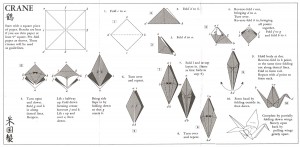
I decided to show the class how to fold paper cranes. I have this habit of doing something with my hands whenever I have the slightest chance to. And the most common thing I seem to do is either make a paper airplane or paper cranes with any spare paper lying around.


























